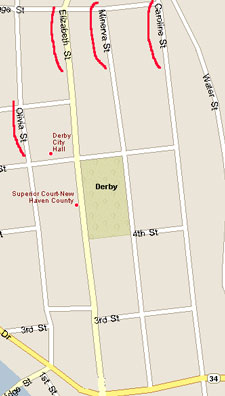Derby History QuizCurrent Quiz Archives of all quizzes
The site of the Derby Green, once known as the Derby Commons, hails back to 1836 when prominent local industrialist Sheldon Smith returned to his home town after making a fortune from commercial ventures in New York City. Smith bought land on the west bank of the Naugatuck River in order to create an industrial borough of the larger community of Derby. He first called his new town Smithville, but later changed the name to Birmingham. Smith then persuaded a business acquaintance from New York, Anson G. Phelps, to join him in founding this new industrial community. In 1836, the two businessmen asked the local selectmen to build a street through the property that already boasted 20 homes and three stores. Smith then hired British engineer and land agent John Cloues to lay out the streets of the downtown. Three principal thoroughfares radiating off Main Street were named for Smith’s daughters, Elizabeth, Minerva and Caroline, and a fourth was named after Phelps’ wife Olivia. The rectangle of land now known as the Derby Green was set aside at that time as a public common to be used by all residents of the thriving industrial community.
Smith later donated land on the north and east sides of the public square for the Methodist and Episcopal churches. Phelps donated land to the west of the Green for the Second Congregational Church. The beauty of the Green was thus enhanced by the addition of three lovely churches to frame its perimeter. In a deed dated April 25, 1845, public ownership of the Green was formalized. The Commons was designated to remain forever a ‘Public Green" on the condition that the citizens of the town build a fence to keep sheep and residents off its grass. On October 4, 1852, a second document transferred ownership to the town for the sum of one dollar, forbidding any buildings to be placed on the land and restricting its use to military or public activities. Fully correct Answers were received from: Pat Shelton, Randy Ritter, Gene Wajdowicz, Kimberly Shelton, Jim Bartlett, Barbara Webber, Mildred Fatterusso, Jack O'Callaghan, Rosalyn Sampiere (Franco), Mary Lou Boroski, and Marsha Pettingill, Partially correct answers came from: Peter Kross, Ron Thomas, Normand Audet, Kristen Jecusco-Casteel, and Frederick Picroski. To see our other earlier quizzes and learn more about Derby's unique history, click here.
|
